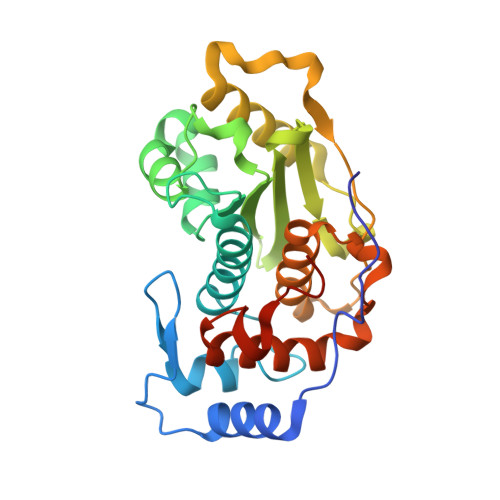Discovery and engineering of enhanced SUMO protease enzymes.
Lau, Y.K., Baytshtok, V., Howard, T.A., Fiala, B.M., Johnson, J.M., Carter, L.P., Baker, D., Lima, C.D., Bahl, C.D.(2018) J Biol Chem 293: 13224-13233
- PubMed: 29976752
- DOI: https://doi.org/10.1074/jbc.RA118.004146
- Primary Citation of Related Structures:
6DG4 - PubMed Abstract:
Small ubiquitin-like modifier (SUMO) is commonly used as a protein fusion domain to facilitate expression and purification of recombinant proteins, and a SUMO-specific protease is then used to remove SUMO from these proteins. Although this protease is highly specific, its limited solubility and stability hamper its utility as an in vitro reagent. Here, we report improved SUMO protease enzymes obtained via two approaches. First, we developed a computational method and used it to re-engineer WT Ulp1 from Saccharomyces cerevisiae to improve protein solubility. Second, we discovered an improved SUMO protease via genomic mining of the thermophilic fungus Chaetomium thermophilum , as proteins from thermophilic organisms are commonly employed as reagent enzymes. Following expression in Escherichia coli , we found that these re-engineered enzymes can be more thermostable and up to 12 times more soluble, all while retaining WT-or-better levels of SUMO protease activity. The computational method we developed to design solubility-enhancing substitutions is based on the RosettaScripts application for the macromolecular modeling suite Rosetta, and it is broadly applicable for the improvement of solution properties of other proteins. Moreover, we determined the X-ray crystal structure of a SUMO protease from C. thermophilum to 1.44 Å resolution. This structure revealed that this enzyme exhibits structural and functional conservation with the S. cerevisiae SUMO protease, despite exhibiting only 28% sequence identity. In summary, by re-engineering the Ulp1 protease and discovering a SUMO protease from C. thermophilum , we have obtained proteases that are more soluble, more thermostable, and more efficient than the current commercially available Ulp1 enzyme.
Organizational Affiliation:
From the Institute for Protein Design.
















